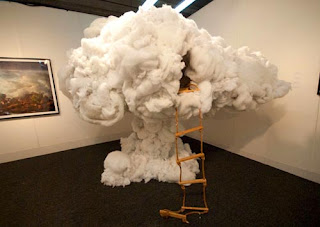 |
| Paul Friedlander pictured with work. |
Dark matter. Invisible existence of matter and light. Creating that which is not there, to see. These are just some aspects of design light artist Paul Friedlander considers when creating light exhibitions. Paul Friedlander is a British born physicist and kinetic light sculptor. Growing up as the son of a professor at Cambridge
University, Friedlander recalls spending long days in his garden, absorbed in his own fantasy world. His first recollection of the news on television was when he was at the age of 6, as the space age began with Russia sending the sputnik to space. It was probably then that Friedlander's fascination with space and cosmology and light began. He describes himself as being a strange child, with little interest in typical child activities. His interest in music sparked with the release of the first Beatles album. In a matter of months Friedlander found his place in the world we refer to today as the counter culture; growing his hair long, rebelling, and later dabbling in the world of cults. In school he did well in physics and mathematics and art(not surprising as his mother was an artist). In 1970, college, Friedlander visited the Hayward Gallery to view the kinetics show.
 |
| Chromastrobic Light Sculpture not spinning |
"I came away from the show convinced that I knew now what I wanted to do with my life. I wanted to create kinetic art. I set about this without delay. I became enthusiastically involved in making kinetic works in my spare time. Very soon I found myself spending more time making art than working on my studies. I set up a simple workshop in my house and found a new way to live."
 |
| Chromastrobic Light Sculpture spinning |
Holding degrees in physics and maths from Sussex University, Friedlander dabbled in cosmology and interstellar propulsion, but later walked a different path, switching to stage lighting design, scientific art, and light sculpting. Friedlander designed light art to play behind the Electric Sound Orchestra, where he created light images to match the sounds the orchestra created. He later created a series of sculptures using chromastrobic light. The sculptures, when spinning give off light illusions.
More recently, Friedlander has focused on light sculpture. He uses chromastrobic light broadcast on string to create his illusions of bent and twisting light.
His interest in kinetic light art has led to his success, having exhibited on 3 continents and 12 different countries in his career as a light artist.
 |
| Paul with light sculptures |
As a designer, I think the most interesting aspect of Friedlander's work is that he strives to create what he cannot see, but he can imagine. His pieces of work are not only pleasing to the eye, but spark one's interest. They cause you to wonder, how is the light moving in a circle? Are the lights really making that shape, or is my brain trying too hard to interpret what I am seeing? With Friedlander's interest in science and cosmology, I think that it is necessary for questions like this. Friedlander's work is brilliant, in how deep he goes to create what he envisions. I think one of the hardest things about the luminary project is learning to manipulate light. Forget having an understanding of light in its scientific form for this gal, because though I understand the connection between light and energy, I don't understand the complexity of light.
 |
| Dark Matter |
In some of the articles I read about Paul Friedlander, people described much of his work stemming from the psychedelic era. I think this observation is interestingly relevant to his work, but as far as I could find on his personal website, he mentioned no credit to drugs or hallucinogens for his curiosity of lights and movement. I think the idea of creating shapes and objects of light is kind of scary for some people, because it is a difficult concept to grasp, and people don't always like to believe what they cannot recreate themselves, or hold in their own hands. I do think that it is very cool that he has direct references to subculture artists, such as Pink Floyd, as he named one of the two giant lights in his piece Dark Matter, the Big Eye.
I have a great appreciation for Pail Friedlander not only as an artist, but as a scientist, a sculptor, and a creator. I think his motivation to create something he has never really seen with the naked eye before, and beyond that to understand it enough to create it is amazing within itself.
credits:
Interactive Architecture
Friedlander's Personal Website




















































